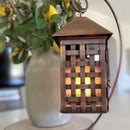Introduction: DIY Under Cabinet Lighting for Cheap!
Some time ago my wife purchased a large, inexpensive hutch for displaying her china collection. It lacked lighting so I first tried installing 3 halogen "puck" lights but these only lit the top shelf and soon became unreliable and burned out. I then decided to install LED strip lighting under each shelf for maximum effect. Off-the-shelf kits are very expensive, as are some kit components like aluminum channels and plastic diffusers. Instead I decided to use just the bare LED strips mounted on simple wood tracks I would make myself. In the end I spent less than $50 to light all four shelves. This Instructable shows the approach I took that hopefully will give you some inspiration and help for a similar project.
Parts List
Here is a list of parts you will likely need. Some components like the connectors and wire will depend on your particular setup:
- LED strip lighting: I chose 5630-type, warm white LEDs in two 5 meter rolls
- LED power supply: 12VDC, 5A capacity
- Remote control dimmer (optional)
- 2-pin JST connectors with jumper wires
- 2-color LED PCB no-weld connectors
- 22-gauge hookup wire
- Heat shrink tubing
- 2 pieces of 1"x3"x8' pine board lumber
- Wood screws
Tools
- Router, router table and bits
- Table saw
- Electric/cordless drill, bit and countersink
- Soldering iron and solder
- Heat gun
NOTE: This Instructable assumes you have basic woodworking skills and the tools listed above. If you don't you can look for pre-cut wood trim pieces that fulfill the same purpose.
Step 1: Choosing the LEDs and Power Supply
If you're new to LED strip lighting there a few basic choices you need to make before you start, specifically the type and color of the LEDs, waterproof or not, and how to power them.
Color
Just like household incandescent bulbs, single-color LEDs come in a variety of hues, typically referred to as "warm" or "cool" white. Light color is measured on a "temperature" scale with "warm white" being about 3000°K and "cool white" about 7000°K. For most residential applications you'll want to stick with warm white as cool white tends to be bluish and sterile. Cool white is great for workshops or other areas that need clear, bright light over aesthetics.
Type
LED light strips feature a series of individual LED components wired in with components to manage the varying current and voltage that can be applied, depending on how long the strip is. LEDs are referred to by a code, such as 3528, 5050 and 5630, that denotes the size of the component. 5630 LEDs are the largest and most prevalent on the market now. Before ordering check the size to make sure it's the one you want.
Waterproofing
You can buy waterproof LED strips, where the entire strip is encased in clear resin, but this is not required in most indoor applications. Plus, it does add some cost. Unless the strip is going to be exposed to moisture (or is likely to be bumped into) the standard, non-waterproof strips should suffice.
Power Supply
LED strip lights run off 12V DC current (though 9V DC can suffice). Power supply suitability depends on how much current (amps or watts) you expect the LEDs to draw. The LED strip specs should list the current requires for the entire strip (e.g., 72 watts). Common power supplies for LEDs are rated at 5 amps or 60 watts. Many LED strip vendors will recommend a power supply you can use and in many cases strips come with a connector so you don't need to do any soldering or wiring. You can compute the required current based on the length of the strip(s) used.
In my case each strip was 5 meters in length (16.4 feet). I ended up using roughly 23 feet total from two rolls. With a rating of 72 watts per roll that works out to about 100 watts total (72 ÷ 16.4 * 23). For direct current amperage is equal to power (watts) divided by voltage so at 12 VDC I would need a power supply rated at just over 8 amps (100 ÷ 12), more than 50% more than the 5A supply I ordered. It is not a good idea to run the LEDs at full brightness since it will overwork the power supply, causing it to run hot and shorten its life. That's one reason I ordered the dimmer. In the long run I will likely upgrade to a 10A power supply like one of these.
Step 2: Lay Out the Build
It always makes sense to spend some time thinking about how your build will go together, especially when it comes to carpentry or wiring projects. Mine was a combination of both. There were a few things I knew I wanted/needed:
- The power supply needed to be on top of the hutch to be out of the way
- I wanted to minimize the wire runs between segments of LED strips on each shelf
This dictated a design that “flowed” down from the top right corner with connecting wires running from one shelf to the one below on alternating sides. You can see this is the image. The electrical outlet is on the wall, behind the hutch.
With this done I knew how much wiring I would need to connect each LED segment.
Step 3: Construct the LED Mounts
As I mentioned previously you can buy prefabricated aluminum channels with integrated diffusers in which to mount your LED strips. I bought a few just to check them out and they are very slick but are also (a) relatively expensive and (b) not in keeping with the aesthetic of the hutch. Therefore, I decided to build my own mounts out of wood. Not only was this more economical but gave me a chance to use more power tools. I have also noticed that you don’t really need the diffusers for many applications, especially if the surfaces are not that reflective.
Even though I was going to paint them I wanted the mounts to be low profile. I also figured that I needed them to be about an inch or so deep. I also wanted the surface the LEDs were mounted to be angled slightly to direct light at the center of the shelves. Therefore, I decided to fabricate two sets out of a single piece of 1x3 pine board lumber but routing out the edges and then ripping the boards lengthwise with my table saw set at a 30-degree angle. I’ve included a schematic view of the boards, end-on, with the routing and cut patterns shown. I tested the cuts on a scrap piece of lumber that you can see in the photos.
The last thing I did was to drill and countersink pilot holes in each wood mount (to make it easier to attach to the hutch) and painted the exposed portions. Note that I left the angled edges where the LEDs strips would be attached bare to ensure good contact for the adhesive backing.
Step 4: Fabricate the Connecting Wires
One other design consideration I had in mind was serviceability. In case one of the four LED strips became problematic I wanted to be able to easily remove and/or replace it. I decided to connect each strip using a combination of PCB and JST connectors plus some standard 22-gauge hookup wire. The PCB connectors attach to the ends of each LED strip to provide power and the JST connectors allow for quick connect/disconnect between segments.
After carefully measuring the distance between each set of shelves I spliced together the components, including additional hookup wire where needed, and secured them with solder connections and heat shrink tubing. This may have been a bit overkill but, again, I got to use more tools.
NOTE: In the end, some of the snazzy PCB connectors didn’t work (likely because they were for 3528 LED strips) and I ended up soldering the wires and JST connectors directly to the copper pads on the LED strips.
Step 5: Measure, Cut and Assemble the LED Strips
Once the wood mounts were cut to size it was a simple matter to attach the LED strips. The LED strips I ordered came with a barrel connector at one end and I utilized this for the first (topmost) strip in the hutch. After clamping one end of the LED strip to the wood mount I measured out enough strip to cover the mount and cut the strip—being carefully to ONLY CUT ON THE GUIDELINES printed on the LED strip. The guidelines bisect the copper pads and if you cut in the middle of segment and not on the guidelines you will disrupt the additional electronics requested for the strip to function. Also, by clamping the strips first I could adjust the length so there was equal overlap at both ends.
With the length determined it was a simple matter to cut the strip size and adhere it by carefully pulling off the paper backing as I pressed it onto the wood mounts.
Step 6: Connect, Test and THEN Mount
Connect, test and THEN mount I would highly recommend that you connect all the segments and test them before mounting them. I was (typically) impatient and tested each one as I mounted it, only to discover that some of the PCB connections were bad. I then had to unmount each strip and repair the connection or, as it turned out, solder the wires into place. Once you have ensured all the segments are working then you can mount them.
I used wood screws, about 7 per strip, to mount the strips to the underside of each shelf. I started at the middle, attaching the strip at an aesthetically pleasing depth, and then proceeded to work out toward the ends. Because neither the shelves nor the strips were exactly square this let me enforce a consistent depth with each screw.
I drilled holes in the corner of each shelf for the connecting wires as well as one in the top for the power supply connection. I secured the wiring (and the IR remote receiver for the dimmer) with Gorilla tape. I could have used something more elegant but it is well concealed and perhaps that gives me a project for another day.











